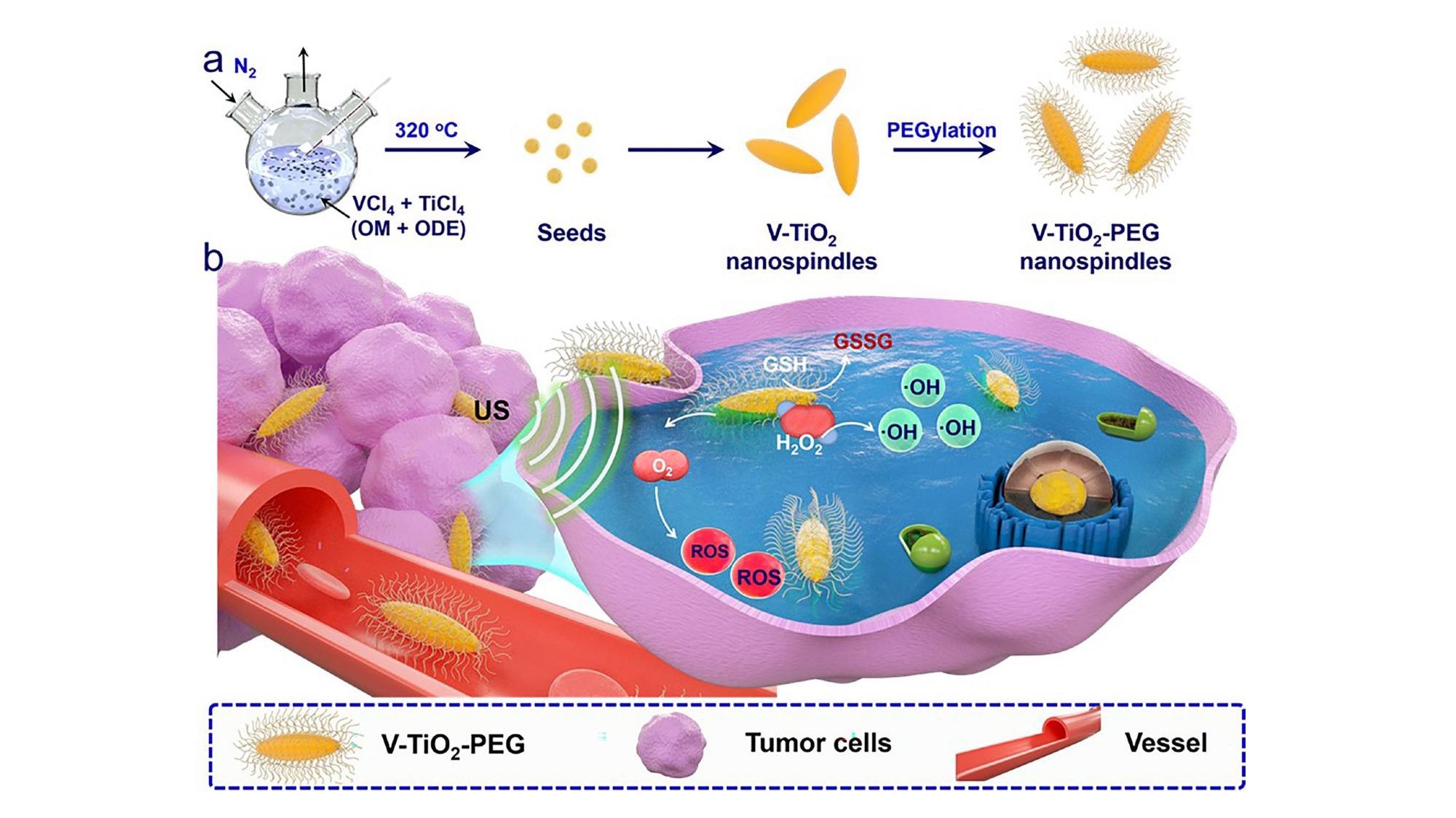Dec 9 2020
Cancer can be treated by using ultrasound in conjunction with molecules sensitizing the system to sound waves. Such sonosensitizers tend to produce toxic reactive oxygen species that attack and destroy tumor cells.
 V-TiO2 nanospindles encased in polyethylene glycol (PEG) and used in combination with ultrasound waves can kill cancer cells. Image Credit: Liang Cheng.
V-TiO2 nanospindles encased in polyethylene glycol (PEG) and used in combination with ultrasound waves can kill cancer cells. Image Credit: Liang Cheng.
Researchers at Soochow University in China have developed a new kind of sonosensitizer based on a vanadium-doped titanium dioxide, V-TiO2, which improves the amount of damage caused by ultrasound on tumors. The study has been reported in Applied Physics Review from AIP Publishing.
Studies in mice revealed that tumor growth was considerably inhibited when compared to a control group.
Although researchers have used organic molecules as sensitizers in the past, these molecules are unstable and can result in phototoxicity, where exposure to light can lead to extreme sunburn or rashes. Moreover, inorganic sensitizers based on TiO2 nanomaterials are used, but these do not serve well and can stay in the body for a longer time.
TiO2 does not function well as a sensitizer as its electronic structure features a wide bandgap. Although the ultrasound removes electrons away from the TiO2 nanoparticles, the electrons tend to quickly recombine with the nanoparticles, thus suppressing the production of reactive oxygen species that could attack the tumor cells.
The investigators found that this effect could be prevented by doping TiO2 nanoparticles with the vanadium metal to create nano-sized spindles.
The band gap of V-TiO2 nanospindles is reduced, increasing the efficiency of ultrasound-triggered reactive oxygen species production compared to that of pure TiO2 nanoparticles.
Liang Cheng, Study Author, Soochow University
The microenvironment surrounding the tumor has a crucial role in the metastasizing of cancer and invading other tissue. It is also vital for the working of chemotherapy and other treatments. Although the pH of the tumor microenvironment is acidic, it also consists of a lot of hydrogen peroxide and a substance called glutathione.
The researchers found that the V-TiO2 spindles serve like tiny enzymes for catalyzing chemical processes in the microenvironment. Upon exposure to ultrasound waves, the spindles enable a two-pronged attack on the tumor—one involves sound waves and the other is a kind of chemotherapy that disintegrates hydrogen peroxide and devours glutathione. Both these effects result in the destruction of tumor cells without any damage to healthy tissue.
The team performed a careful study on both breast cancer tumor cells and on mice infected with these cancerous cells, using controls. Besides direct measurements related to tumor growth, they used fluorescent probes to observe reactive oxygen species and glutathione when the process was underway.
It is worth noting that V-TiO2 nanospindles are rapidly excreted from the body. This helps prevent any possible long-term toxicity effects.
Liang Cheng, Study Author, Soochow University
The researchers could visualize V-TiO2 nanospindles in the liver and spleen of the mice and, eventually, in the urine and feces. There were no evident signs of organ damage or inflammation, indicating that these sensitizers are both effective and safe.
Journal Reference:
Wang, X., et al. (2020) V-TiO2 nanospindles with regulating tumor microenvironment performance for enhanced sonodynamic cancer therapy featured. Applied Physics Reviews. doi.org/10.1063/5.0027606.